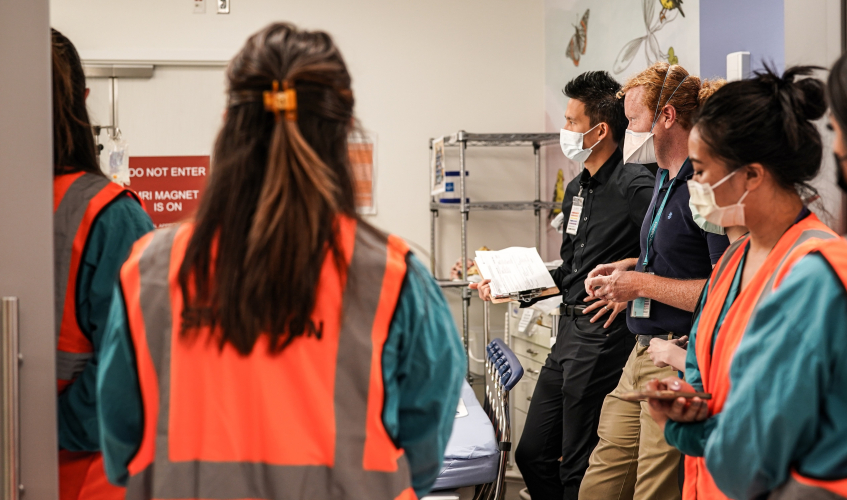Amy Sprague
October 16, 2024

Nick Tom (third from right) learns about challenges his team can address at Seattle Children's Hospital.
For Nick Tom (ISE B.S. '13 and current board member), the transition from aerospace manufacturing to healthcare was more than just a career change—it was a calling. As the manager of improvement consulting at Seattle Children's Hospital, Nick found his true inspiration in the organization's clear mission: serving kids.

ISE alum Nick Tom
"Coming from aerospace manufacturing, it's rewarding to have a more direct connection to helping people," Nick reflects. "The healthcare field presents challenges, but the mission of serving these kids is inspiring."
At Seattle Children's, Nick leads a team of continuous improvement consultants who apply Industrial and Systems Engineering (ISE) principles to enhance operations across the hospital, foundation, and research arms of the organization. Their primary focus is on the hospital, where the need for efficiency and improvement is most pressing.
Nick and his team employ a structured approach to problem-solving, following lean principles that are the cornerstone to ISE. "We follow a structure starting with intake, assessment, planning, intervention, and sustainment," Nick explains. This methodology allows them to partner effectively with business leaders, identifying challenges and implementing solutions that make a real difference in patient care.
One of the team's current major initiatives involves value stream mapping across 11 key departments to improve patient access. "We're using value stream mapping to allow patients to see providers on a greater scale, trying to reduce things such as patients unable to schedule appointments," Nick says.
The ISE toolkit proves invaluable in their daily work. Nick's team utilizes a variety of techniques, including 5 Whys, cause and effect trees, affinity diagrams, and Ishikawa diagrams. Many of their projects culminate in Kaizen events or rapid process improvement workshops (RPIWs), where teams come together for multi-day intensive problem-solving sessions.
These ISE principles have led to tangible improvements across the hospital. The most significant project over the last couple of years was leading the organization in operational readiness process improvements when the hospital opened the new 310,000-square-foot Forest B hospital building. A major win was focused on enhancing pharmacy processes. "We looked at the picking process, labeling process, and quality checks," Nick recounts. "Through a multi-year project, we made improvements in efficiency, allowing us to do more with the same number of people."
In another project, Nick's team tackled the unique issue of reducing outpatient infusion authorization denials and write-offs. By using root cause analysis to find out the real reason for denials and write-offs and holding a kaizen event to create solutions with buy-in from all subject matter experts, they were able to drastically reduce the number of denials and write-offs, impacting the hospital bottom line.
While technical skills in areas like stochastic modeling and statistical software are important, Nick emphasizes that change management is crucial in healthcare. "When you're trying to convince senior leaders or surgeons, change management skills are crucial," he notes, recommending familiarity with models like Prosci's ADKAR (Awareness, Desire, Knowledge, Ability, Reinforcement) model.
As the healthcare landscape evolves, Nick sees emerging trends that ISE students should be aware of, particularly in artificial intelligence and big data analysis. However, he stresses that the ability to manage change and work effectively with diverse teams remains paramount.
For students aspiring to make a difference in healthcare through ISE, Nick offers valuable advice: "Find a mentor. Don't be afraid to reach out to people on LinkedIn or at career fairs and networking events. You really have to put yourself out there to learn and gain experience beyond what you get in the classroom."